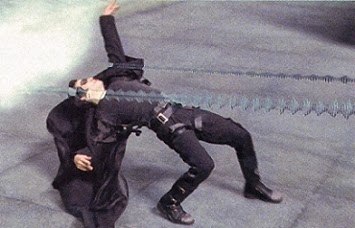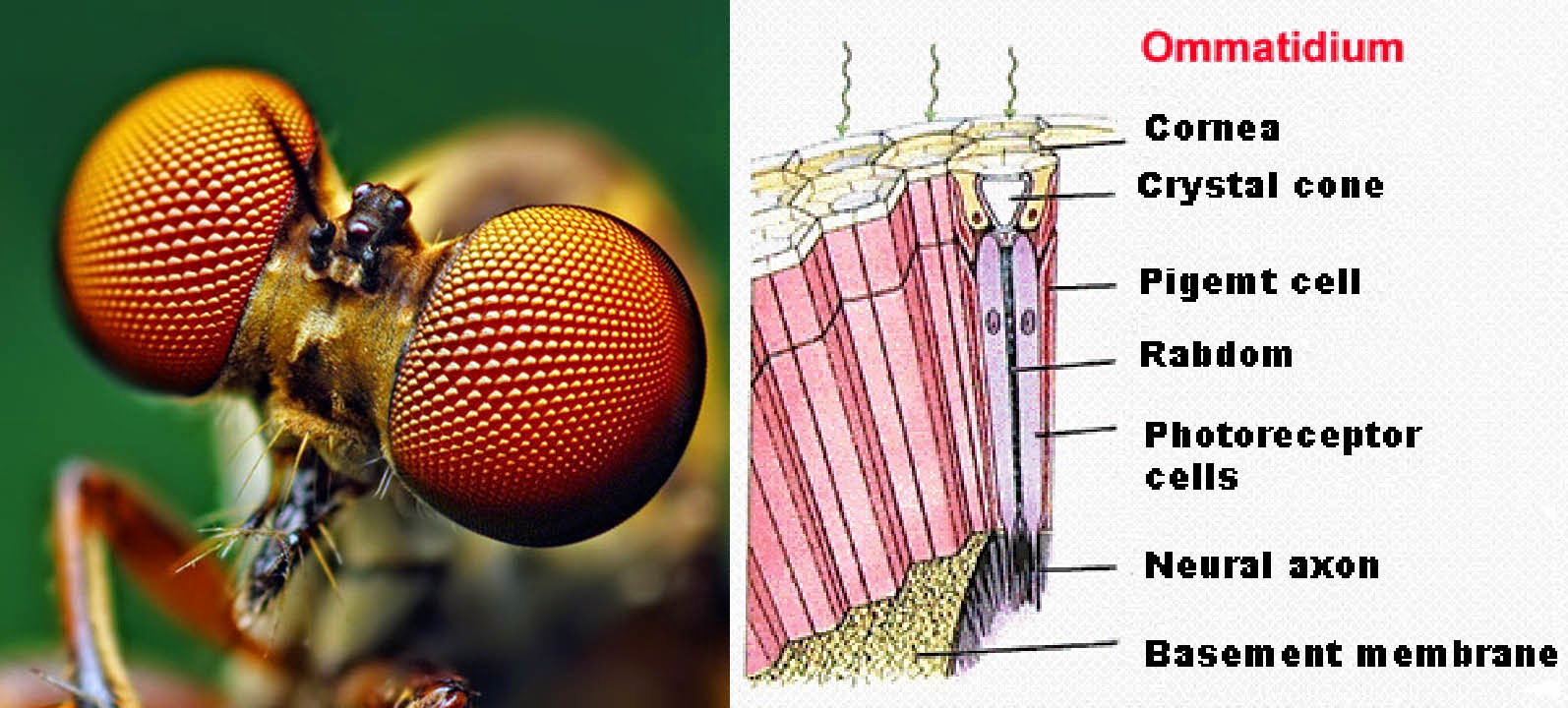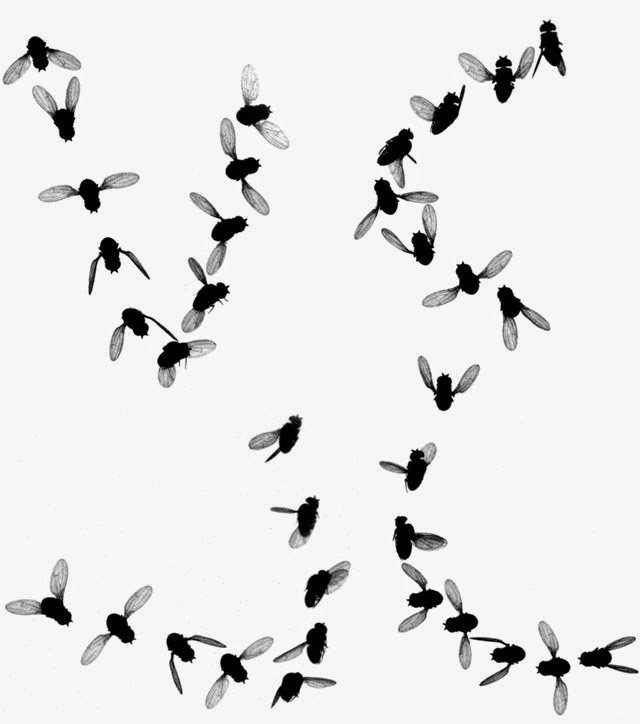Biology
Biology Concepts ? ommatidia, reflex, fly, arthropod, sensory receptors, sensilla, metabolic rate, life span
Neo from the Matrixfilms had the ability, once he learned to accept it, to react so fast that everything around him seemed to be moving slowly. It made for cool cinema, but could it be real? It can seem so, athletes in ?the zone? describe their situation as if everything else is moving slower and their task becomes much easier.
Each ommatidium senses light changes or objects, so a large moving object (like a fly swatter) will be picked up by several thousand eyes and will alert the fly. The ommatidia aren?t particularly good at resolving objects, but the fact that there are so many of them makes the fly very good at detecting movement. So the fly flies away and you curse under your breath.
They saw that the fly can bank and turn all the way over or pull up and fly back over its own head in a flipping motion in order to change direction. They move their body, and they counter with subtle wing movements to reorient themselves within just 1.5 wing beats - and they beat their wings over 200 times a second. (see video)
A 2013 study has taken this observation even further. Small animals with higher metabolic rates tend to process stimuli faster as well. They can sense, process, interpret, and react to a stimulus in the same amount of time a human needs to recognize the snowball that's coming at his head.
Muijres FT, Elzinga MJ, Melis JM, & Dickinson MH (2014). Flies evade looming targets by executing rapid visually directed banked turns. Science (New York, N.Y.), 344 (6180), 172-7 PMID: 24723606
Healy K, McNally L, Ruxton GD, Cooper N, & Jackson AL (2013). Metabolic rate and body size are linked with perception of temporal information. Animal behaviour, 86 (4), 685-696 PMID: 24109147
Jumpertz R, Hanson RL, Sievers ML, Bennett PH, Nelson RG, & Krakoff J (2011). Higher energy expenditure in humans predicts natural mortality. The Journal of clinical endocrinology and metabolism, 96 (6) PMID: 21450984
- Drosophilla
Term: drosophillaOrigin: Anc Greek??????/drossos(=dew, young animal)+?????/philos(=loving)> ?????/phileo(=love, kiss)+ ?/a(= feminine suffix) literally meaning "dew loving" DefinitionDrosophilla is any of a genus (in the family Drosophilidae), of tiny...
- The Best Cure For Insomnia Is To Get A Lot Of Sleep
Biology concepts ? theories of sleep, REM sleep, circadian rhythms, neural plasticity You open the door to your house and find your roommate sprawled out on the couch. Is he sleeping, unconscious, or dead? Knowing your roommate, you figure it could be...
- Tough As Nails
Biology concepts ? keratin, crystalline form, cornification, regeneration, stem cells Horns are made from keratin, just as are nails, hooves, and hair. Believe it or not, this is a real picture of a condition called a cutaneous horn. It is...
- Sweet Suffering
Biology concepts ? nociception, cranial nerve, headache, referred pain, vasodilation, mechanoreceptor Nancy Johnson, a Philadelphia housewife, received a patent for the hand crank ice cream freezer in 1843. She sold the patent for 200 dollars because...
- Do You Have Be Ugly To Hear Well? ? Owls And Body Plan Symmetry
Biology concepts ? body plan, bilateral symmetry, cephalization, form follows function Paradox alert ? the most complex organisms in nature are the best at reducing complexity. How is that? Nature tends toward symmetry through evolution. Lower organisms...
Biology
Because He Is The One
Biology Concepts ? ommatidia, reflex, fly, arthropod, sensory receptors, sensilla, metabolic rate, life span
 |
| Neo (Keanu Reeves) learned that he could dodge bullets at one point in The Matrix. This was before he learned he didn?t have to. Was he speeding himself up so the bullets looked to be going slower, or was he actually slowing down time? |
Let?s look at a case of this in nature. Today?s question ? Why is it so hard to catch or swat a fly? The answer involves fighter jets, optical illusions, and yes, time manipulation.
Ever try to catch a fly? It ain?t easy. Swatting them can be frustrating even though most fly swatters have an area that is more than 350x bigger than the fly itself. It?s even harder to catch or hit them with your hand, and it?s as big or bigger than a fly swatter. We aren?t all as skilled as Pat Morita and his chopsticks in The Karate Kid.
One big reason that it?s hard to catch or swat a fly is because they know you?re coming. It?s not mental telepathy or a glimpse into the Matrix; it?s just that house flies (Musca domestica) and fruit flies (Drosophila melanogaster) as well as many other types of flies have sensory apparatus to let them know something big and powerful is coming at them.
First of all, look at their heads. They are almost all eyes. Each eye is not a single sensory organ, but is made up of 4000 individual ommatidia (omma = eye and tidium = small). Each ommatidium faces a slightly different direction, so all together, they give the fly a 360? field of vision. You can?t sneak up on them unless they?re asleep or dead.
 |
| The fly eye is a wonder to behold. Technology is using their design (stealing really) to make smaller, cheaper magnifying camera lens, to make better robotic eyes, solar panels, and to reduce glass fogging on windows. The ommatidium on the right is the basic unit. Fruit flies have about 800 in each eye, house flies have about 4000. |
Even if you do swing at a distracted, contemplative, or sleeping fly with your rolled up newspaper, book, or hand ? you?re still most likely to miss. Flies have sensilla (see this post) on their bodies that contain sensitive mechanoreceptors. The object moving toward them creates an air pressure wave that distorts the receptors. This sends a neural impulse through the giant fibers that make up much of the fly?s reflex arcs, and they immediately fly away.
This is why fly swatters are usually made of plastic or metal mesh. The little holes reduce the amount of air that the swatter pushes toward the fly, so that he's less likely to sense his coming doom. This is also one of the reasons it?s harder to hit them with your hand. Your hand is solid, so it pushes more air toward the fly. But also, the lever arm of the fly swatter (the long handle) creates a greater angular velocity, so it's traveling faster toward the fly than you could move your hand alone.
 |
| This is a weird illustration, but work with me. When a band marches around a corner, they guys on the outside part of the turn have to march much faster to stay in line. Now, when swatting a fly, your hand is the guy on the inside of the turn, and the tuba on the outside, running to keep up, is the flyswatter. See why it?s easier to hit a fly with a swatter ? more speed. |
The quick reaction due to visual or mechanical stimuli is even more amazing when you consider the tarsal reflex. Wing movements are inhibited when the fly is resting on your egg salad. It can't flap when its legs a resting on a surface. A startled fly has to overcome the tarsal reflex inhibition before it can fly away.
Interestingly, the reflex problem for the fly turns into a problem for you. To overcome the tarsal reflex, the mesothoracic (middle) legs push off and the fly jumps. Now it isn?t in contact with a surface and can therefore flap its wings. But the jump is always away from your impinging deathblow. Take a look at this video to see the jump. A 2008 paper showed that the fly plans the jump up to 200 milliseconds (0.002 sec) before its flight, so that it will jump directly away from the approaching object. He?s evading you even before he really starts trying.
Fruit flies and house flies can avoid most attempts at assassination just through these actions, but they have other tools at their disposal as well. For one thing, they can turn away from an approaching object and head off in another direction in only 0.03 seconds. The same group that conducted the 2008 study also showed in 2014 paper how a flying fly avoids visually perceived objects.
 |
| Count how few wing beats it takes for these flies to turn almost 180 degrees ?it?s about one and a half. In the top right turn, you can see how they almost do a loop de loop, and they all show the subtle changes in wing and body position need to pull off the turn. |
And now we get to the relationship between flies and Neo (other than the observation that Mr. Anderson can fly). To a fly, we mere mortals seem to be moving in slow motion. This phenomenon has to do with their metabolic rate.
It was observed long ago that bigger animals tend to live longer than smaller animals. It was also known that smaller animals had faster heart rates and faster metabolic rates (they make and used energy faster) than larger animals. This led to the rate of living (ROL) hypothesis of life span. The faster your metabolism, the shorter your lifespan. This hypothesis fell out of vogue as oversimplified, but has made a remarkable comeback in the last decade.
In fact, a 2011 study showed that people with slower heart rates and lower resting metabolic rates tend to live longer than people with faster resting metabolic rates. It seems that, ?Live fast and die young,? is more than just a macho platitude.
 |
| Knock On Any Door was the book and movie that introduced the phrase, ?Live fast, die young, and leave a good-looking corpse.? Bogart didn?t say the line; he was the attorney for the kid who did. But ?live fast, die young? has been the title for two movies, three pop songs, and biography of James Dean. |
It?s as if (not really) time moves slower for the smallest animals as compared to us. This is yet another reason that the fly is likely to avoid reading your People magazine from very close up. Like Neo seeing the bullets in flight or the coming head butt from Agent Smith, flies sense and react on a completely different time scale.
This makes me feel better. Some mayflies live only 5 minutes as a flying adult (see this post), and house flies have a life span of about three weeks regardless of whether you hunt them or not, but this doesn?t have to be so sad. If time passes slower for flies, then maybe their life is long enough to fulfill all their dreams and learn about love, loss, and which wine goes with which meat. What?s important is not the minutes in their life, but the life in their minutes.
- Drosophilla
Term: drosophillaOrigin: Anc Greek??????/drossos(=dew, young animal)+?????/philos(=loving)> ?????/phileo(=love, kiss)+ ?/a(= feminine suffix) literally meaning "dew loving" DefinitionDrosophilla is any of a genus (in the family Drosophilidae), of tiny...
- The Best Cure For Insomnia Is To Get A Lot Of Sleep
Biology concepts ? theories of sleep, REM sleep, circadian rhythms, neural plasticity You open the door to your house and find your roommate sprawled out on the couch. Is he sleeping, unconscious, or dead? Knowing your roommate, you figure it could be...
- Tough As Nails
Biology concepts ? keratin, crystalline form, cornification, regeneration, stem cells Horns are made from keratin, just as are nails, hooves, and hair. Believe it or not, this is a real picture of a condition called a cutaneous horn. It is...
- Sweet Suffering
Biology concepts ? nociception, cranial nerve, headache, referred pain, vasodilation, mechanoreceptor Nancy Johnson, a Philadelphia housewife, received a patent for the hand crank ice cream freezer in 1843. She sold the patent for 200 dollars because...
- Do You Have Be Ugly To Hear Well? ? Owls And Body Plan Symmetry
Biology concepts ? body plan, bilateral symmetry, cephalization, form follows function Paradox alert ? the most complex organisms in nature are the best at reducing complexity. How is that? Nature tends toward symmetry through evolution. Lower organisms...
